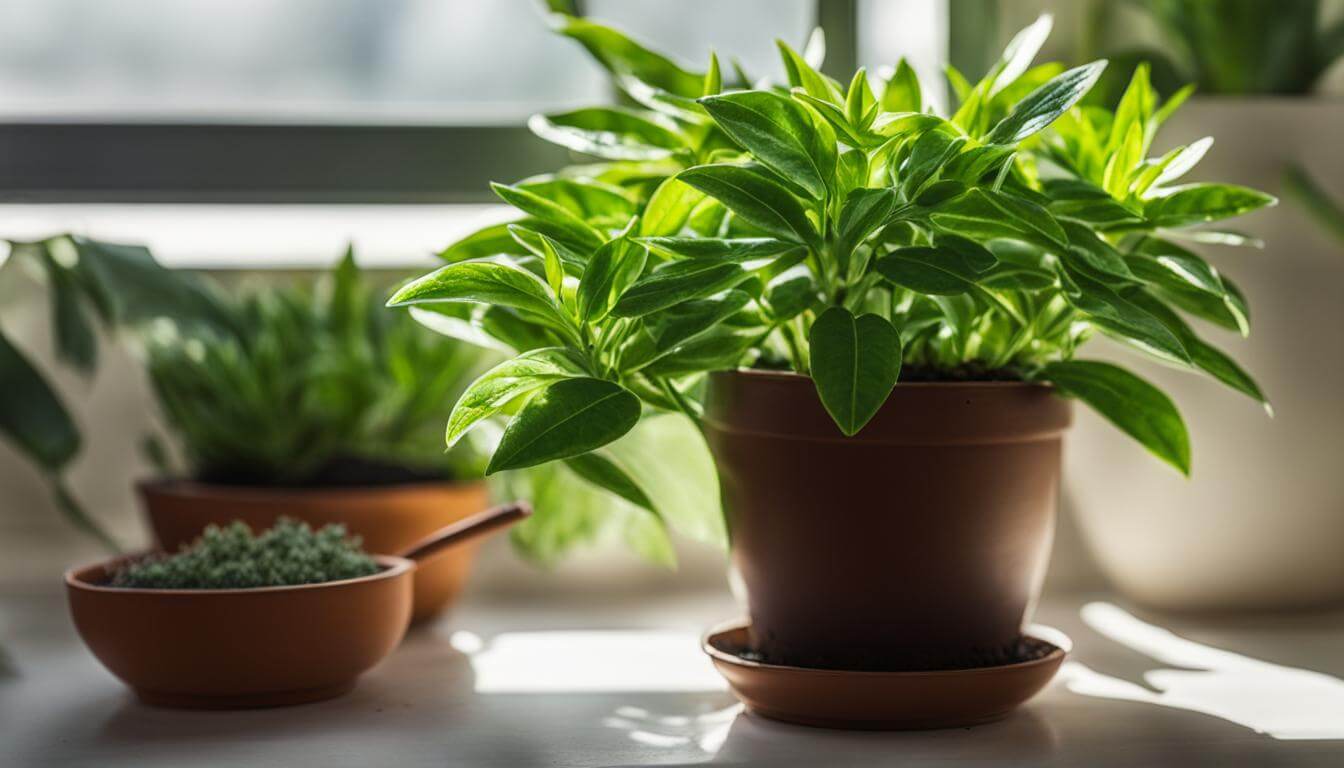Flaming Katy, also known as Kalanchoe blossfeldiana, is a popular and low-maintenance indoor succulent plant that adds vibrancy to any space. Native to Madagascar, this evergreen shrub belongs to the Kalanchoe family in the Crassula genus. With its striking flowers available in various colors including scarlet, yellow, pink, orange, and white, Flaming Katy is a favorite among plant enthusiasts.
To ensure your Flaming Katy thrives and blooms abundantly, it’s important to provide proper care and address common issues. In this article, I will discuss the possible causes of a Flaming Katy plant not producing flowers and provide solutions to help you enjoy its beautiful blooms.
Key Takeaways:
- Flaming Katy, or Kalanchoe blossfeldiana, is a low-maintenance indoor succulent known for its vibrant flowers.
- Proper care includes providing bright but indirect sunlight, well-draining soil, and allowing the soil to dry out between waterings.
- Flaming Katy plants require a resting period with reduced light exposure, lower temperatures, and decreased watering to encourage future blooming.
- Common issues with Flaming Katy plants include overwatering, root rot, and mealybug infestations, which can be prevented or treated with proper care and maintenance.
- Regular pruning and repotting every few years can promote healthy growth and ensure the longevity of the plant.
How to Care for Flaming Katy Plants
Flaming Katy, also known as Kalanchoe blossfeldiana, is a stunning succulent plant that can brighten up any indoor space. To ensure your flaming Katy thrives, it’s important to provide the proper care and maintenance.
Firstly, flaming Katy plants prefer a bright location with indirect sunlight. Avoid exposing them to direct sunlight at midday, as it can be too harsh for the plant. The ideal temperature range for flaming Katy is between 18 and 22°C. Extreme temperatures can affect the plant’s growth.
When it comes to watering, flaming Katy plants should be watered sparingly. Allow the soil to dry out between waterings to prevent overwatering, which can lead to root rot. It’s also essential to plant your flaming Katy in well-draining soil to ensure proper drainage.
| Care Tips for Flaming Katy Plants |
|---|
| Provide bright, indirect sunlight |
| Maintain a temperature range of 18-22°C |
| Water sparingly, allowing the soil to dry out between waterings |
| Plant in well-draining soil |
| Fertilize during the flowering period with a balanced water-soluble fertilizer |
| Prune and repot every two to three years |
| Provide a rest period with reduced light exposure, lower temperatures, and decreased watering |
| Inspect for mealybug infestations and treat with appropriate insecticides |
Proper care, including adequate light, well-draining soil, and appropriate watering, can help prevent common problems and ensure healthy growth for your flaming Katy plant.
By following these care tips, you can enjoy the beauty of vibrant blooms and lush foliage from your flaming Katy plant. Remember to keep an eye out for any signs of wilting, yellowing leaves, or pest infestations, and take prompt action to address these issues. With the right care, your flaming Katy will thrive and become a stunning addition to your indoor space.
Troubleshooting Flaming Katy Flower Problems
Flaming Katy plants, also known as Kalanchoe blossfeldiana, are beautiful succulents that can bring vibrant color to your indoor space. However, like any plant, they can encounter problems that prevent them from blooming. If you’re experiencing issues with your Flaming Katy’s flowers, here are some common problems and their solutions:
1. Wilted leaves and yellowing
If you notice that your Flaming Katy has wilted leaves or yellowing foliage, it could be a sign of overwatering and root rot. To remedy this, make sure to allow the soil to dry out between waterings. Only water the plant when the top inch of soil is dry. Additionally, ensure that your Flaming Katy is planted in well-draining soil to prevent excess water buildup.
2. Powdery mildew
Powdery mildew is a common fungal disease that can affect Flaming Katy plants. If you see a white powdery coating on the leaves, it’s likely powdery mildew. To treat this issue, use an appropriate fungicide and make sure to provide good air circulation around the plant.
3. Mealybug infestations
Mealybugs can be a common pest problem for Flaming Katy plants. These small insects can cause wilting and damage to the plant. To get rid of mealybugs, you can use soapy water or an appropriate insecticide. It’s also important to regularly inspect your plant for any signs of infestation and take action promptly.
By addressing these common problems and providing proper care, you can help your Flaming Katy plant thrive and produce beautiful flowers.
FAQ
Why is my Flaming Katy without flowers?
There could be several reasons why your Flaming Katy is not flowering. Common causes include insufficient light, incorrect temperature, overwatering, and not providing enough rest periods. To encourage blooming, make sure your plant is receiving adequate indirect sunlight, maintain a temperature between 18 and 22°C, water sparingly allowing the soil to dry out between waterings, and provide a rest period with reduced light exposure, lower temperatures, and decreased watering.
How do I care for Flaming Katy plants?
To care for Flaming Katy plants, place them in a bright location with indirect sunlight. Use well-draining soil and water sparingly, allowing the soil to dry out between waterings. Fertilize with a balanced water-soluble fertilizer during the flowering period. Regularly prune and repot the plant every two to three years. Provide a resting period with reduced light exposure and lower temperatures to encourage blooming. Protect the plant from common issues such as wilting, yellowing leaves, and mealybug infestations.
How can I troubleshoot Flaming Katy flower problems?
If you are experiencing issues with Flaming Katy flowers, common problems could include wilt, powdery mildew, root rot, and overwatering. To troubleshoot, ensure that you are providing proper care by allowing the soil to dry out completely between waterings, using well-draining soil, and avoiding overwatering. Additionally, provide adequate light exposure, maintain appropriate temperature levels, and take preventive measures against fungal diseases and pests.







